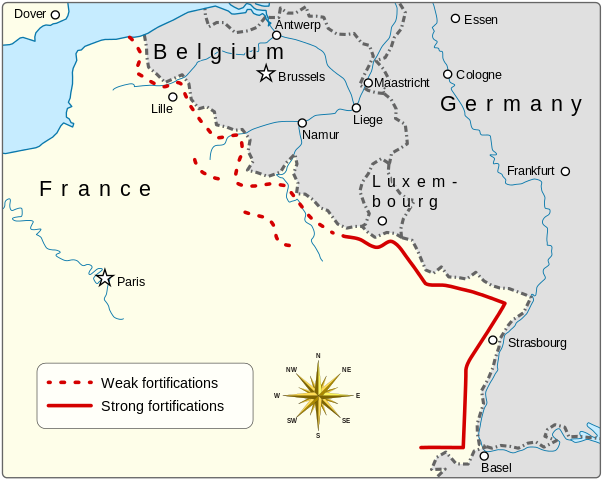In the aftermath of World War 1 in 1918, the French were absolute in their resolve that the German ‘war machine’ would never again roll across France. The effect of WWI had destroyed much of France; an estimated 6 million French soldiers had perished in brutal trench warfare and combat. The Minister of War, André Maginot, was adamant that France would never again suffer such loss.
Building the Maginot Line
In an effort to protect their borders, the French government built defenses to repel future German advances. Thus began the famed “Maginot Line”; a series of underground bunkers, turrets, blockhouses, hospitals, munition stores, an underground rail, power and communications systems, outposts, and observatories that stretched for 300 miles along the eastern border of France. The infrastructure and construction was an immense undertaking in both time and cost (estimates now range that the total cost as much as $9B in 2019 USD).

The strategic placement of these lines were clear, but a decision was made to not build significantly along the Belgian border; prevailing wisdom was that the French would not be caught by surprise if an invasion had to come through the densely-forested Belgian territory. Any movement by German forces through Belgium would provide adequate time for the French to assemble and respond. These defenses were designed to keep Germany out and, save for a stretch across the Belgium/French border, they were indeed formidable. The French were prepared for a future land war against Germany.
But June, 1940 was not like 1918.
World War II was not fought in the trenches like WWI. Hitler’s army had fast-moving, long-range Panzer tanks with their 88-mm armor-piercing guns. Modern fighter airplanes commanded the sky and heavy artillery dominated the battlefield. Movement became a competitive advantage; German mobility and speed formed a new combination aptly nicknamed ‘blitzkrieg.‘ European nations fell quickly to the Nazi juggernaut. But the Maginot Line was designed for a very specific effort – to protect the eastern border against oncoming German forces. Hitler would not get into France and repeat history. At least, so the French thought.
Instead of fighting along the Maginot Line, the German army poured through Belgium (the famed blitzkrieg tactic on display) and drove north around the Maginot line and all the immobile defenses. French forces on the Maginot Line held brilliantly – but against virtually no enemy. German forces flanked to the north and crossed into France. There was no time to recover from their mis-appropriation. The nation fell in just six weeks, broken militarily, emotionally, and spiritually, because they were defending against the wrong offensive move. The French had prepared for the wrong war.
What We Can Learn From Maginot?
For our businesses, we must be aware of our own “Maginot Lines.” What worked last year might not work this year. Opportunities change and competitive natures adjust. Do we fortify our sales strategies with the same ‘tried and true methods’ that worked before? Maybe we resort to what is comfortable and known? Rather than seek challenges or upset the applecart, we become complacent. Or, perhaps we embrace industry changes and adapt to our new environment?
Maybe something (like mobility and speed!) has become a new competitive advantage. Are we too stuck in our former ways to see the change?
It’s imperative that we change correctly and avoid building our own pointless bunkers and abatements; we must adopt new strategies and seize opportunities. Otherwise, maybe we’re preparing for the wrong war.
Critics of Maginot sometimes fail to remember that the defenses built to deflect a German invasion did perform as they were designed. Finding fault within the process isn’t the point, of course. The effort was clear and the objective was correct. It’s just that France put the wrong effort into the wrong objective. We cannot afford to make the same mistake.
My Recommendation:
In your next biz chat, ask each other the tough question, “What do you see as the ‘Maginot Line’ in my business? What do you think I’m missing? How do you think I can improve?” Listen to the answers we receive. Maybe they’re uncomfortable (although surely more comfortable than a Panzer tank rumbling towards us!) and acting may be tremendously valuable for our business in the coming year.that
